Menu
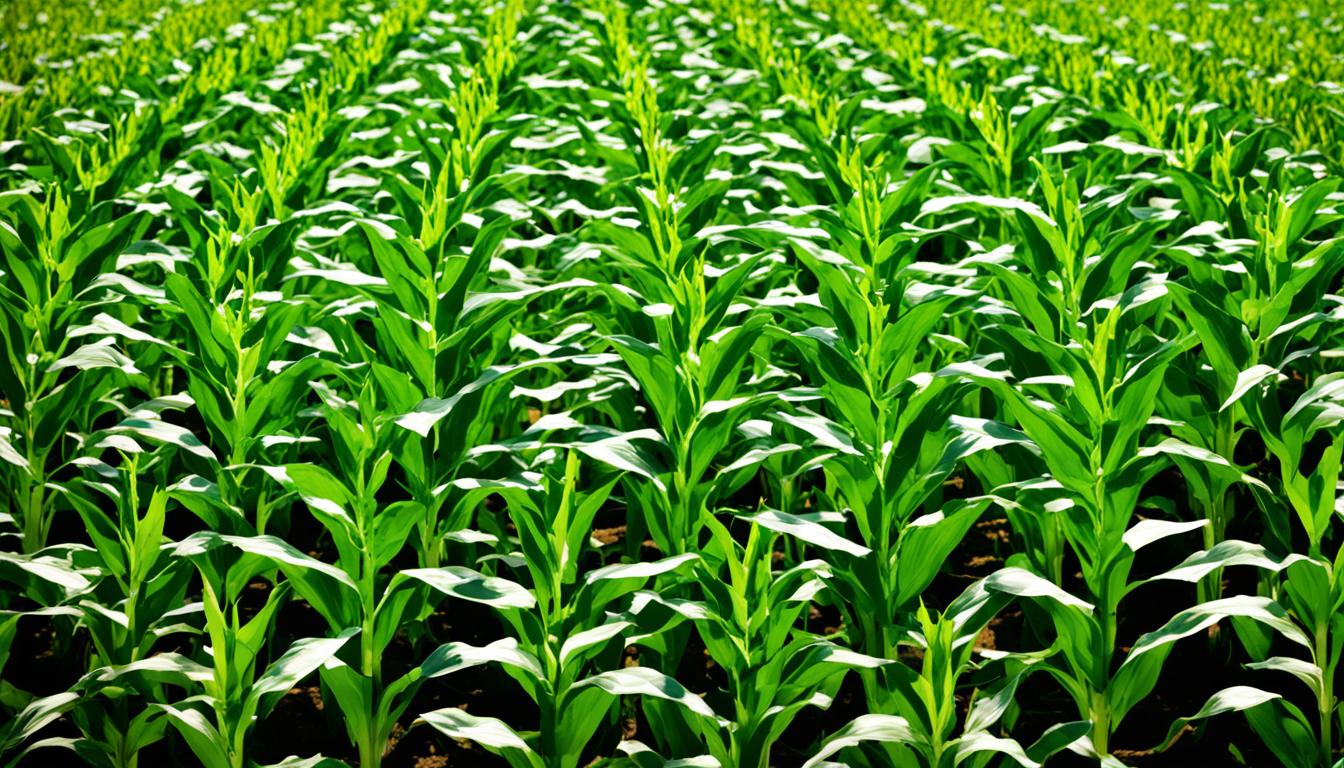
Did you know that as of 2012, biotechnology was behind around 88% of corn planted in the US? It also influenced 94% of cotton planting and 93% of soybeans. These figures highlight the vast impact of biotechnology in agriculture.
Biotechnology in agriculture uses various methods. This includes traditional breeding and the newer genetic engineering. It changes the genetic code of organisms to get certain traits. These can be things like higher crops yields and better quality. This branch of science is helping farmers grow more food while also looking after the environment.
Agricultural biotechnology brings together biology, genetics, and technology. It aims to improve the quality and amount of food we produce. By using these tools, we can make crops better suit our needs. This makes farming more efficient and helps protect the environment.
Biotech crops are now widely used around the world. In 2012, most of the corn, cotton, and soybeans grown in the United States were biotech. This success shows that genetic engineering can help with pests, making food better, and increasing harvests.
Crops that can withstand herbicides, like soybeans, corn, and cotton, have been developed. This means less toxic herbicides are needed, which is better for nature and people. Cotton plants that can fight off insects on their own have also cut down on the use of harmful pesticides.
Biotechnology has been key in fighting off diseases that can threaten important crops. For example, genetic modification saved the U.S. papaya industry from a destructive virus. Research continues to improve the nutritional value of food, helping fight deficiencies worldwide.
Groups like the USDA, EPA, and FDA carefully check the safety of biotech crops. Their work ensures these technologies are good for people and the planet. They also support new discoveries to keep improving farming.
| Type of Crop | Biotechnology Planting Percentage (2012) |
|---|---|
| Corn | 88% |
| Cotton | 94% |
| Soybeans | 93% |
By using agricultural biotechnology hand in hand with advanced farming methods, we’re looking towards a brighter farming future. This future farming will be more plentiful, eco-friendly, and able to tackle big issues like climate change and changing food needs.
Genetic engineering is key in farming, changing crop genes to add good traits and improve output. Gene editing is a leading method because of how well it works. It lets scientists quickly make plants that do well in different places. This is crucial for future farming success.
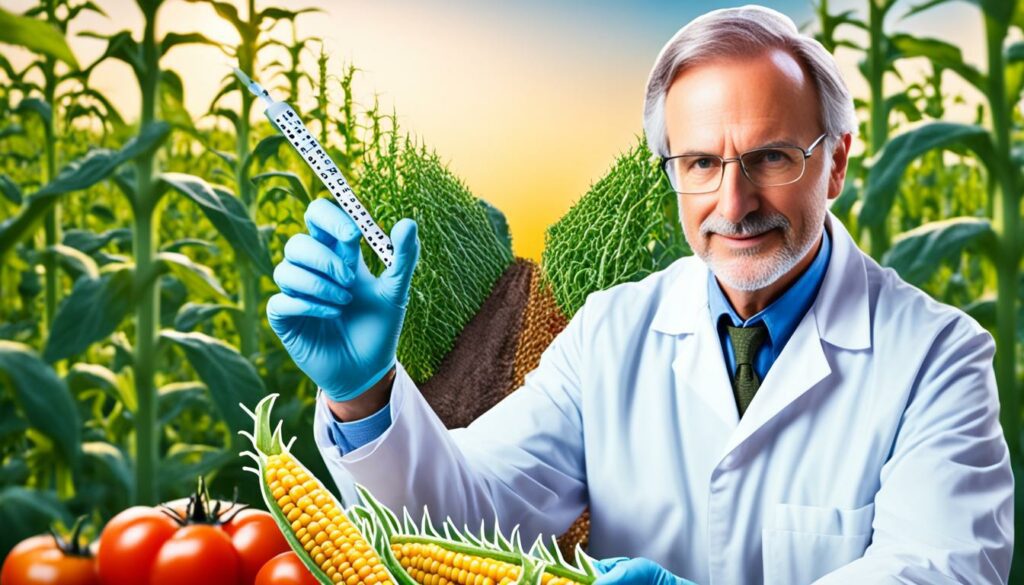
Gene editing uses techniques that make specific changes in plant genes. Early tools like TALENs and ZFNs were important steps. But now, CRISPR/Cas9 is the new star.
CRISPR allows very precise changes in a plant’s genes. It’s been a big help, for example, in making plants that resist weed killer. In 2012, most of the corn, cotton, and soybeans in the U.S. were gene edited, showing how well this works.
CRISPR also lets us make foods more nutritious or that can grow in tough conditions. Rice with extra beta-carotene, and better oils in canola and soybeans, are just a few examples. These innovations are key for a future where food is reliable, no matter the climate.
To sum up, CRISPR/Cas9 is transforming agriculture. It makes improving crops faster and more precise. These advances are crucial for keeping our food supply safe and growing.
Genetically modified organisms (GMOs) offer big benefits in farming. They increase crop yields and make food more nutritious. Since the 1990s, GMO crops have helped farming a lot. They have made farming better for both the economy and the environment.
GMO crops like those that resist insects or withstand herbicides increase how much food we get. They let farmers grow more food per acre. This is important for feeding everyone. For example, crops that can grow without tilling the soil save on labour and fuel. They also keep the soil healthy.
One well-known GMO crop is the Rainbow papaya. It is resistant to viruses and was introduced in 1998. Now, it is grown a lot in Hawaii and sent to Japan. This shows how GMOs can help in real farming. They play a big role in making more food and wasting less.
GMOs also make food more nutritious. Golden Rice, for instance, is rich in Vitamin A. It’s vital in places where many people lack this vitamin.
Many other GMO crops are being used to make things like healthier oil and apples that stay fresh longer. This means less food is wasted, and the food we eat is of better quality.
Studies show that from 1996 to 2012, GM crops have been really good for farmers and consumers. They have boosted income and food production a lot.
There have been successful projects, like USAID’s work in Bangladesh. They’ve rolled out GMO eggplants. This has made farmers earn more and cut back on harmful pesticides.
| Benefit | Example | Impact |
|---|---|---|
| Increased Yield | Herbicide-tolerant crops | Enhanced productivity, soil health, and reduced fuel use |
| Enhanced Nutrition | Golden Rice | Alleviation of Vitamin A deficiency |
| Economic Impact | Rainbow papaya in Hawaii | Expanded cultivation and export to Japan |
In short, GMO crops offer many benefits. They are key in improving farming and fighting hunger. They help make farming more sustainable and tackle food security in a big way.
Farming has improved a lot with the use of biotech crops. This new way mixes science with old farming techniques. It has made growing crops more efficient and better.
The key is to pick crops that grow well in certain places. For example, some crops can handle stronger weed killers. These killers break down fast in the soil and don’t harm animals or people.
Using these crops is good for the planet. It means better quality crops and more money for farmers. Plus, by using special cotton that insects don’t like, less chemical pesticides are needed. This helps saves the environment.
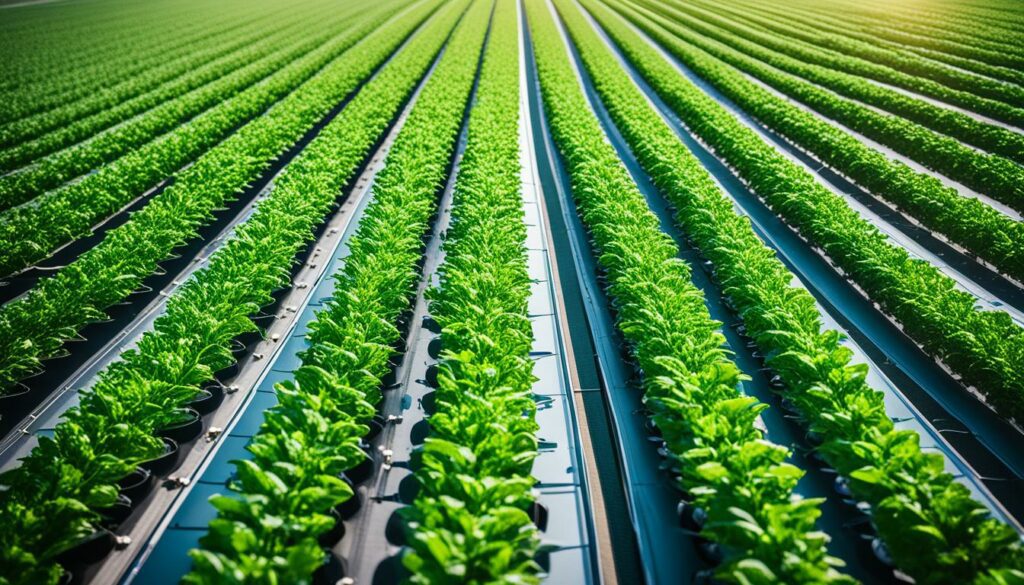
Precision farming uses high-tech tools to watch over fields. It gathers details from space, under the ground, and from the air. This helps farmers decide how to plant, water, and feed their crops.
With this tech, farmers can change things right away. It cuts down on using too much water or fertiliser. This makes farming better for the earth and gets more crop. So, it’s a step towards smarter and greener farming.
| Crop | Percentage of Biotech Plantings in 2012 | Percentage of Biotech Plantings in 2020 |
|---|---|---|
| Corn | 88% | 92% |
| Cotton | 94% | 96% |
| Soybeans | 93% | 94% |
This table shows that more and more farmers are using biotech crops. From 2012 to 2020, the use of these special crops has slightly grown. This tells us that farmers are finding these methods very helpful.
Gene editing has changed agriculture through techniques like CRISPR-Cas9. This method won the 2020 Nobel Prize in Chemistry for its big impact. It’s being used all over the world because of its power. It has already shown many successes in farming.
In the United States, the number of patents for CRISPR in farming has been steadily growing since 2014-2015. This trend shows the nation leading in this area, with Australia and Canada close behind. Europe’s progress is better than most of Asia, showing quick adoption and new ways to use gene editing.
China is a big player according to WIPO, with a quarter of the patents coming from there. Even though China does a lot of advanced research on gene editing, it still has unclear rules on it. This situation encourages global talks about making rules that fit everywhere for this developing field.
The advancements from gene editing are also big economically. The market for agricultural biotechnology was worth about USD 40 billion in 2020. But with tools like CRISPR/Cas9 and more, it might reach USD 110 billion by 2030. These tools help make crops better by changing their genes directly.
There have been successful tests on a range of crops in different countries. China, the United States, and Japan have grown crops like rice and maize that are improved by gene editing. Some examples include GABA-enriched tomatoes in Japan. This shows that gene editing can make food crops better, stronger, and more nutritious.
The use of gene editing also touches on important areas like laws and ethics. Many studies have been done to look at these topics all over the world, from Canada to the EU. This research helps different places think about the best ways to use and regulate gene editing in crops.
Gene editing can help crops deal with tough conditions like drought and floods. Reports say these changes are needed due to climate change. It’s affecting crop growth negatively in some places and hurting livestock in others. Gene editing aims to make food production more resilient in these changing conditions.
In the end, the stories of gene editing in agriculture are mostly about success. They show how this new technology can make farming more sustainable and deal with food needs. Ongoing studies and new rules will keep showing the advantages of gene editing in farming.
Agricultural biotechnology has pushed the boundaries in making crops that fight off diseases. It also tackles pests more efficiently. It does this by using genetic engineering. This makes crop plants better at fighting off illnesses from pathogens and problems caused by pests.
When it comes to pest control, biotechnology helps by making plants more resilient. This is done through genetic changes. Bacillus thuringiensis (Bt) toxins are an example. They fight off insects well. This means crops can be healthier. It reduces the need for chemical sprays, helping the environment.
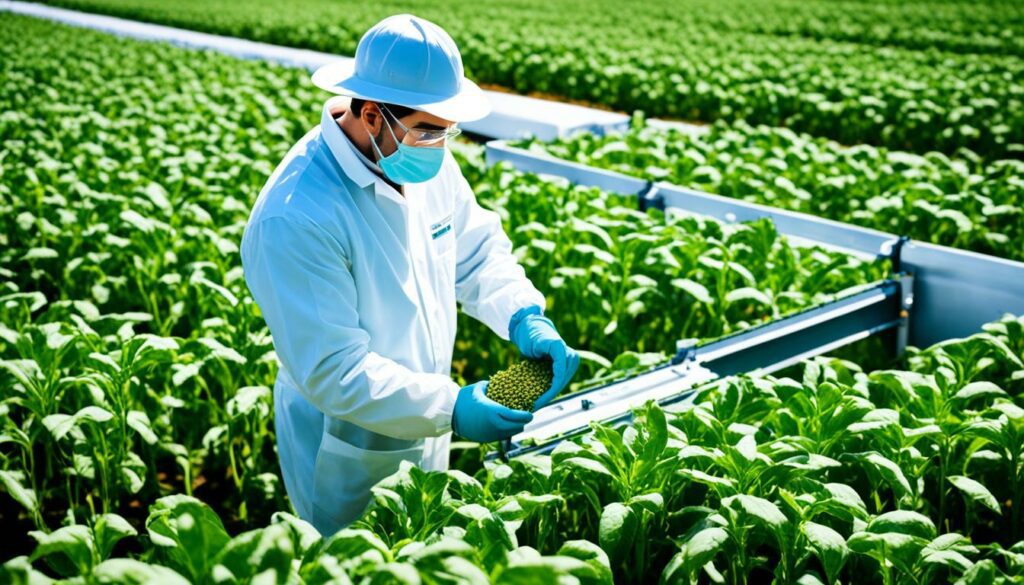
There have been great strides in creating crops that don’t get sick. Diseases can really harm crop production. For example, bacterial and fungal diseases can cut yields by about 15%. Viruses can make it even worse, causing up to a 3% drop.
Thanks to genetic engineering, plants can now make their own disease-fighting tools. They stop harmful enzymes. They even make substances that beat back viruses. This technology has made some crops very strong against their usual viral attackers.
Techniques like CRISPR allow very precise changes to plant genes. This is done without adding new DNA. As a result, it’s easier to get crops with great traits. This happens quicker than with old ways of breeding.
All this is crucial as the world’s population keeps growing. With many more mouths to feed, farming must keep up. By making crops that fight off sickness and bugs, we secure our food future. Plus, it’s better for the planet, too.
Bioengineered seeds are changing the game in farming. They improve how much we can grow and how well we protect our crops. They also cut down on the need for harsh chemicals. This new way of farming is becoming very popular. Farmers are using bioengineered seeds more and more.
In the last few years, we’ve seen big steps in making better seeds. In the USA in 2012, most of the corn, cotton, and soybeans were made from biotechnology. These crops need fewer pesticides and can survive more pests. They also let farmers use better, safer herbicides that don’t stay in the soil for long.
The world is embracing bioengineered seeds for a good reason. A global report by ISAAA shows they are effective and safe. The comeback of the U.S. papaya thanks to genetically modified varieties is a great example. Now, over 40% of U.S. farms use GMO crops.
These advanced seeds help farmers be more efficient and make more money. Farmers from all over trust that bioengineered seeds are safe, thanks to checks by USDA, EPA, and FDA. They help increase farm produce without harming people or the planet. That’s a win-win for everyone.
Biotech crops have many good effects on the environment. They help lessen soil erosion and save water and nutrients with better farming methods. This leads to more sustainable ways of growing crops.

They cut down on deep ploughing, which keeps the ground stable and stops soil loss. For example, in the U.S. in 2012, biotech corn, cotton, and soybeans showed they could protect the soil well. So, these crops can make it easier for farmers not to dig up the soil, which prevents erosion.
Certain biotech crops, like insect-resistant cotton, have reduced the need for strong pesticides. This means less pollution of water with harmful chemicals. Also, using biotech corn, cotton, and soybeans allows for safer weed killers. These new weed killers don’t stick around in the environment, protecting plants and people alike.
Also, biotechnology creates crops such as papaya that are less vulnerable to diseases. This boosts their sustainable growth and cuts down on the use of things like fuel, fertiliser, and pesticides. Not only does this help nature, but it also keeps crop production eco-friendly.
| Biotech Crop | Environmental Benefit | Example |
|---|---|---|
| Corn | Reduced soil erosion | 88% biotech planting in the U.S. (2012) |
| Cotton | Significant reduction in pesticide use | 94% biotech planting in the U.S. (2012) |
| Soybeans | Facilitates no-till farming | 93% biotech planting in the U.S. (2012) |
| Papaya | Disease resistance | Sustainable industry growth |
Biotech crops bring big benefits to farming and the environment. They are key in moving towards farming that is good for the planet and for keeping nature safe.
Precision farming combines advanced tech and old farming ways for better results. It lets farmers watch their crops closely and respond fast to their needs.
Using big data in farming means gathering lots of information about crops, weather, and soil. This info helps make smart decisions to grow more food. In the future, we might have tools that read DNA quickly, making farming even smarter.
Automation in farming is moving tasks from people to machines. This tech includes drones and tractors that drive themselves. They’re great at mapping fields, finding issues, and checking soil. They help farmers use resources wisely.
| Technology | Application | Benefit |
|---|---|---|
| GPS | Mapping irrigation systems, tractor driving | Improves accuracy and efficiency |
| Drones | Remote crop monitoring, soil assessments | Provides real-time insights, minimises labour |
| Satellite Imagery | Crop health monitoring, nutrient level analysis | Enables precise planning and resource management |
Although precision farming can cost a lot in the beginning, it brings many benefits. It saves money, keeps soil healthy, and boosts the harvest. With help from the government, it’s becoming more common, making farming better for the planet.
In agriculture, Agri-genomics changes the game by exploring crop genes. Advanced tools like next-generation sequencing boost farming and breeding. Its main goals are to map crop genes and help crops grow better using genetic data.
Crop genome mapping is vital in Agri-genomics. It means carefully studying DNA to discover what makes crops work. Creating detailed genetic maps helps find what helps crops grow strong. For example, some wheat kinds have much more DNA than humans. Thanks to new tech, looking at all this DNA isn’t as hard as it once was. This progress helps make crops better.
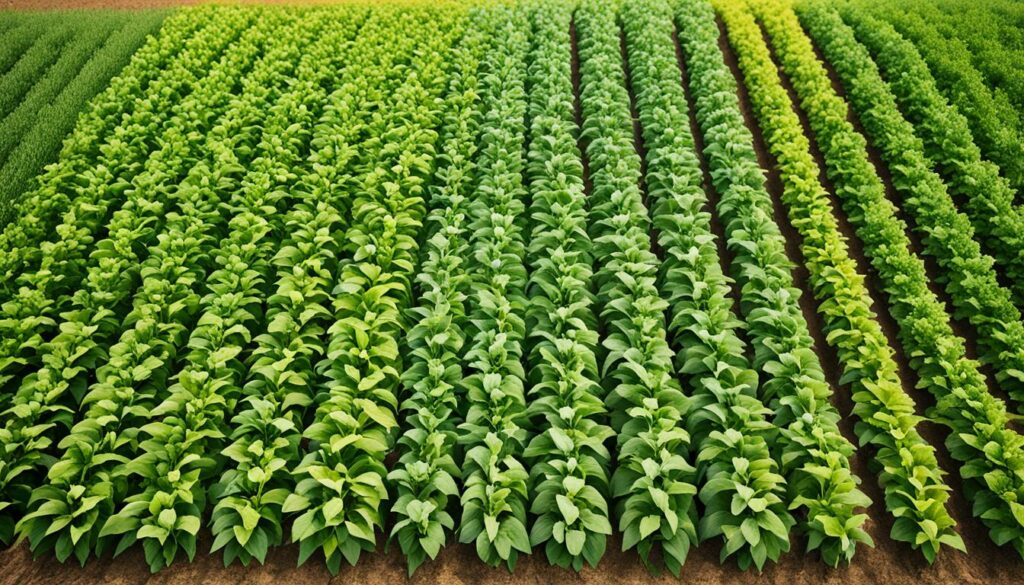
Data from mapping genes is key in making crops better. Scientists use this information to create crops that fight off disease and need less water. This is important for farming and making biofuels.
Mapping genes also helps make food safer and more available. Better and faster DNA tests mean we find helpful information quickly. This leads to getting new crop types approved for use more quickly. Agri-genomics is crucial for solving food problems. Crops like wheat and rice can become even more useful. We’re just at the start of what we can do with it, promising a better future for farming.
Approximately 854 million people are malnourished in 2022, making up 12.6% of the world. This shows the urgent need for biotechnology in food security. Genetically engineered crops, like drought-tolerant wheat, offer a promising way forward. In Brazil and Argentina, this wheat grows 20% more and sequesters 7% more carbon, even in droughts.
Biotechnology also plays a vital role in sustainable food production with staples like golden rice. Since 2000, golden rice has fought provitamin A deficiency, helping reduce preventable child blindness. This highlights how biotech can improve the nutritional value of food, especially for those lacking important nutrients.
Ninety-one percent of U.S. corn farms use genetically modified seeds, and 84% grow herbicide-tolerant corn. This leads to less dependence on chemical sprays, which is better for the environment. Genetically modified corn sees a 10% yield increase, thanks to 8-9% larger leaves. This showcases how biotechnology boosts efficiency.
Genome editing techniques also show great promise. A type of rice edited to have 30% bigger grains could cut methane emissions by over 10%. This would benefit food security and the environment alike.
| Parameter | Statistic |
|---|---|
| Global Malnourishment (2022) | 12.6% (854 million people) |
| Daily Food Insecurity in U.S. | 2.4 million people |
| Corn Farm Acreage using Herbicide-Tolerant Varieties in U.S. (2016) | 84% |
| Benefits of Drought-Tolerant Wheat | 20% higher yield, 7% increased carbon sequestration |
Biotechnology has a major impact on our fish supply too. Over three billion people depend on fish for a big part of their protein. Genetically modified salmon in the U.S. and Canada reach optimal weight quicker. This means they need less food and water, lowering harm to the environment. These innovations are crucial as wild fish stocks decrease due to climate change.
In sum, biotechnology is essential in the fight against global food insecurity. By enhancing crop yields and improving nutritional value, it paves the way for a more secure food future.
Keeping agricultural biotechnology safety top priority is vital. It means following strict regulatory guidelines set by lawful bodies like the USDA and EPA. In 2012, around 88% of corn, 94% of cotton, and 93% of soybeans in the U.S. were biotech varieties. This underlines the need for careful safety checks.
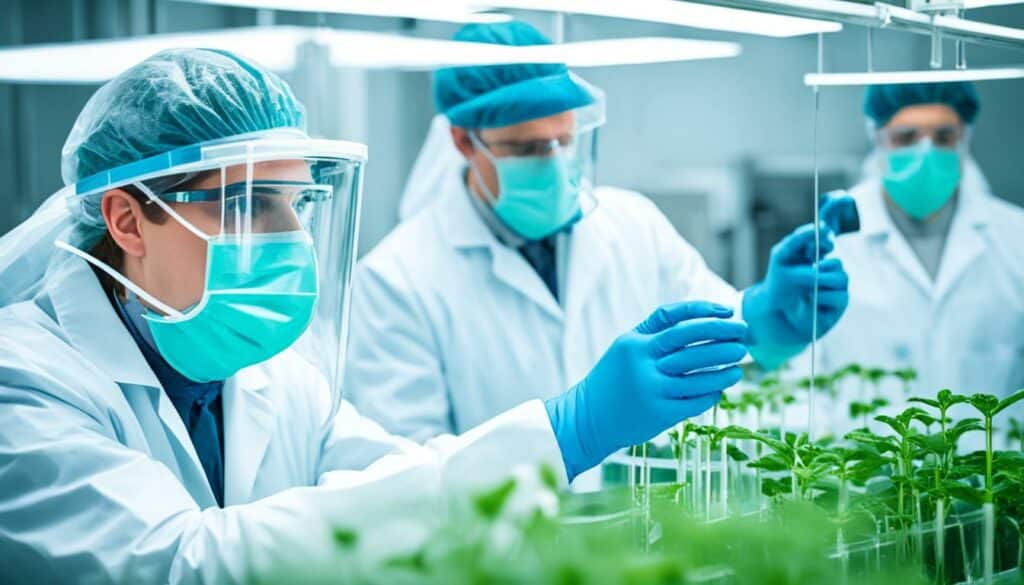
The USDA and EPA work hard to keep health and environmental impact controlled. They look at the risks from these crops to us and nature. This includes checking if new genes might jump to wild plants and affect animals like birds, mammals, and insects.
When it comes to traits like resistance to bugs or diseases, these checks make sure things stay in balance. It’s all to stop any harm to our current ecosystems.
The USDA and EPA also study the proteins made by these crop traits. They make sure they are safe to eat and feed animals. These checks are very detailed, looking at health and big-picture ecosystem effects.
Since the first GM crops in 1995, these reviews have been key. They allow for farming innovation while keeping agricultural biotechnology safety at heart.
Biotech farming is changing to meet our growing food needs, which could go up by 70% by 2050. Laws ensure these crops help without harm. As technology grows, so do the rules to keep everything safe and healthy.
The U.S. has greatly boosted its crop yields using biotech methods. For example, in maize, these changes have made a big difference. This shows how important it is to have fair and smart regulations. These rules back new ideas in farming while looking out for health and the environment.
Agricultural biotechnology faces many hurdles, especially in developing areas. The slow adoption of herbicide-tolerant crops in places like Africa and South Asia is a key issue. These crops don’t always match the local plants and environment. So, they may not be very useful. Even though Bt cotton can grow more, it might not do well in certain areas.
Genetically engineered seeds often don’t fit well with local crops and nature. In developing countries, these seeds sometimes don’t work because they don’t meet the area’s farming needs. It’s not just about the science—it’s also about making sure the tech is affordable for small farmers.
There’s also a problem with jobs. In places where people usually pull weeds by hand, using herbicides can mean women lose work. This can hurt these local communities. It shows we need to use new tech in ways that don’t harm important jobs.
Deciding what biotechnology to focus on can be tricky. Leaders in developing countries often don’t have much money or enough advice. They rely a lot on private companies to pick what to invest in. But this way, we might miss checking how safe and good new products are properly before we sell them.
Decision-makers in agriculture need more robust scientific advice to set research agendas, ensuring that the full potential of biotechnology is harnessed responsibly.
To sum up, the challenges we’ve talked about can be seen in this table:
| Challenge | Detail |
|---|---|
| Adoption in Developing Countries | Not tailored to local crops and conditions; herbicide-tolerant crop penetration slow |
| Economic Accessibility | Technology must be affordable for small-scale farmers |
| Socio-economic Disruption | Herbicide-tolerant crops could displace manual labour, affecting rural women |
| Performance in Suboptimal Conditions | Transgenic seeds like Bt cotton may underperform in less-than-ideal environments |
| Leadership and Priority Setting | Biotechnology priorities often set by private sector, driven by market forces |
Dealing with these agricultural biotechnology challenges and understanding limitations of genetic engineering can help. This way, we can make agriculture more sustainable and help everyone globally.
We are at an exciting moment in the world of agricultural biotechnology. It’s clear that the future looks promising. We’re on the path to making crops grow better and be of higher quality. This means our food can be both plentiful and good for the planet.
Biotech crops, like corn and soybeans, are becoming common in the U.S. They show us that changing genes can really help farming. These techniques work well and are easy to use.
The progress in farming thanks to biotechnology is just the beginning. It has also helped in areas like making vaccines. These vaccines are better at fighting some very bad diseases we see in animals. The methods used are so precise. For example, scientists can easily change genes with the help of special enzymes. This has led to new and better plants and animals.
However, not everyone is ready to fully embrace biotechnology. Some still worry about its safety and how it might affect the environment. Also, there are concerns about its impact on poorer countries. There, some farmers find it hard to use these technologies.
To move forward, we need smart rules and ways that put people first. This will help make sure that everyone can benefit from biotechnology. And, it will make our food supplies strong and safe for the future.
Agricultural biotechnology uses modern methods like genetic engineering to change living things. This improves agricultural products by enhancing their features or creating new ones.
Genetic engineering adds new qualities to plants for better results. Techniques like CRISPR/Cas9 allow scientists to tweak DNA accurately. This makes plants stronger against dangers like diseases and harsh conditions.
GMO crops lead to bigger harvests, more nutritious food, and less damage from pests and diseases. They cut down on chemical use. This helps farming be more eco-friendly and sustainable.
Precision farming personalises farming to each plant’s needs using data and tech. This boosts crop growth and ensures resources are used well. It increases efficiency and cuts down on waste.
Gene editing has made crops resilient and more nutritious. For instance, disease-resistant crops and plants with better nutrients. This shows how powerful genetic engineering can be for feeding the world.
Biotechnology makes crops more robust against pests and diseases. This means less need for harmful chemicals. It’s good for the plants, the environment, and the creatures that live there.
Bioengineered seeds boost crop yields and make them hardier. They also cut down the need for certain farming inputs. More farmers are choosing them for better, greener farming.
Biotech crops help protect the land and water. They make farming more efficient, using less often and keeping the soil better. This supports the earth for the long term.
Precision farming uses high-tech tools to watch plants closely and manage farms better. It makes hard work easier with machines. This makes farming smarter and more productive.
Agri-genomics studies crops’ genetic makeup to find ways to make them better. It’s key for developing plants that can deal with tough conditions.
Biotechnology creates crops that can feed more people with better food. This helps produce food sustainably for our growing population, using fewer natural resources.
Strict rules make sure crops from biotechnology are safe. They check if genes can jump to wild plants, test new features, and make sure products are safe before selling them.
There are hurdles like ethics, how the public sees it, and effects on nature. Overcoming these needs clear talk, constant study, and careful use of these technologies.